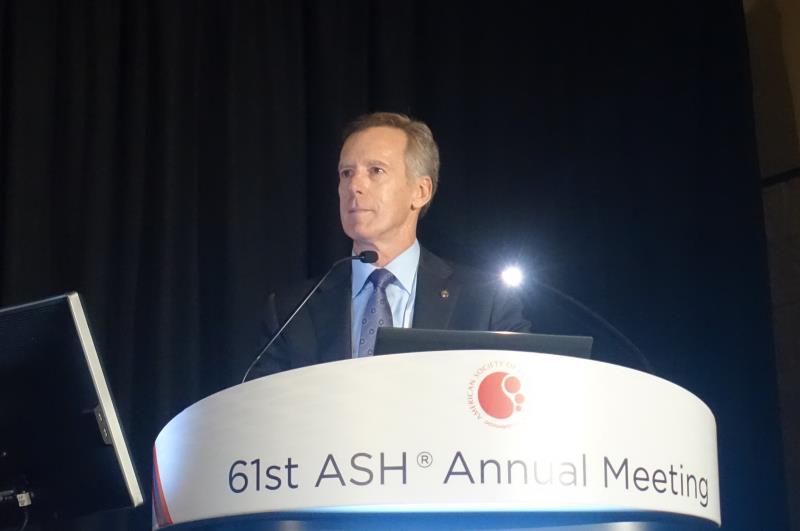 Dr Alan List
Dr Alan ListAdding epoetin alfa (EA) to lenalidomide significantly helps achieve major erythroid response (MER) in patients with erythropoietin (Epo)-refractory, lower risk non-deletion 5q (non-del(5q)) myelodysplastic syndrome (MDS) compared with lenalidomide alone, according to the final results of the E2905* trial presented at ASH 2019.
“We previously reported that lenalidomide restores sensitivity to Epo in MDS progenitors by inducing the formation of lipid rafts that are enriched for signalling competent, Janus kinase 2/Epo-receptor complexes,” said lead author Dr Alan List from the Moffitt Cancer Center in Tampa, Florida, US.
This phase III trial evaluated 195 MDS patients (median age 74 years, 71.3 percent male) with IPSS** score of low- or intermediate-1 risk disease, haemoglobin level of <9.5 g/dL, and transfusion-dependence (TD) of >2 units/month prior to randomization. Participants were randomized to receive either lenalidomide with EA (combination therapy; 10 mg/day PO for 21 days Q4W + 60,000 units/week SC Q4W; n=99) or lenalidomide alone (n=96). Patients who did not respond to lenalidomide alone at 16 weeks were crossed over to the combined therapy (n=44). [ASH 2019, abstract 842]
List highlighted that the median red blood cell transfusion burden was 4 units/8 weeks in both treatment arms, and 93 percent had prior erythropoiesis-stimulating agent (ESA) treatment at baseline.
In the intention-to-treat (ITT) analysis, a higher percentage of patients treated with lenalidomide plus EA achieved MER at 16 weeks than those treated with lenalidomide alone (28.3 percent vs 11.5 percent; p=0.004), which “was highly statistically significant”, List noted.
Of the 44 lenalidomide monotherapy non-responders who were crossed over to lenalidomide plus EA combined therapy, 25 percent of whom also achieved MER at 16 weeks.
Although the minor erythroid responses (ER) were comparable in both treatment arms (18.2 percent vs 20.8 percent; p=0.72), overall ER was improved with lenalidomide plus EA vs lenalidomide only (46.5 percent vs 32.3 percent; p=0.05).
In a subset of patients with MDS with ringed sideroblasts (MDS-RS), lenalidomide plus EA led to improved MER vs lenalidomide alone (34.6 percent vs 20.0 percent; p=0.16).
Similar to the findings in the ITT cohort, minor ER in the MDS-RS subset did not differ between the combination therapy and lenalidomide alone (17.3 percent vs 20.0 percent; p=0.79). Nonetheless, overall ER was improved with lenalidomide plus EA vs lenalidomide alone (51.9 percent vs 40 percent).
Use of the combination therapy also led to a longer MER duration*** than lenalidomide alone, both in the ITT population (median, 23.8 vs 13.0 months; log-rank p=0.24) and in the MDS-RS subset (median, 16.3 vs 13.0 months; log-rank p=0.41).
“[Our results showed that] lenalidomide can restore sensitivity to epoetin alfa in Epo-refractory, lower risk-non-del(5q) MDS patients to yield significantly higher rates of ER compared with lenalidomide alone,” List concluded.
“The results of this study [also] support the use of combined lenalidomide and EA for the treatment of patients with IPSS low- or intermediate-1 risk, non-del(5q) MDS who are unresponsive or refractory to ESAs,” List added. “Combination treatment was safe with no greater risk of thromboembolic events or frequency of AML progression.”
*E2905: Lenalidomide with or without epoetin alfa in treating patients with myelodysplastic syndrome and anaemia
**IPSS: International Prognostic Scoring System
***The interval between the documented date of MER (end of 8 weeks) and the first date of RBC transfusion or reduction in haemoglobin ³2 g/dL